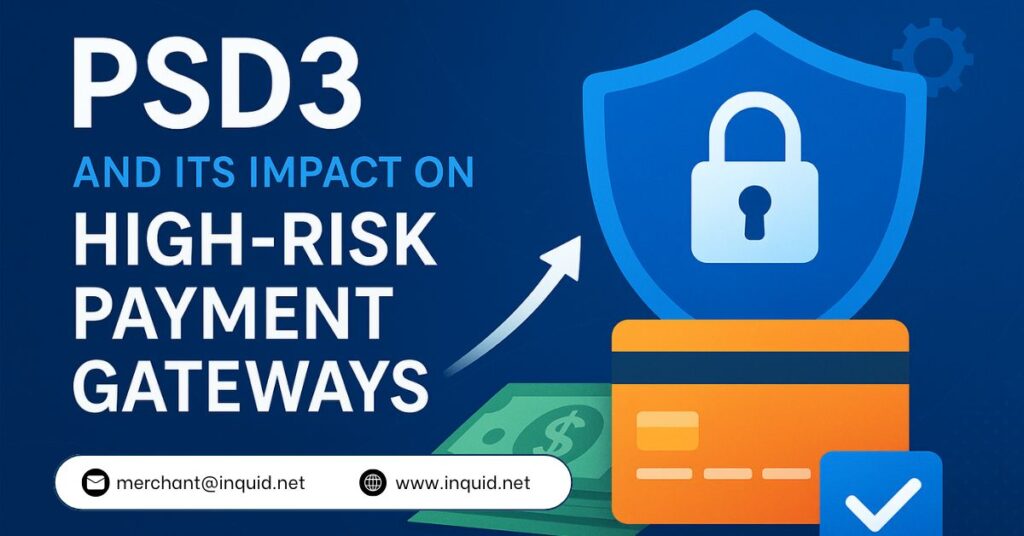
Understanding PSD3 in Context
The European Union has introduced the third Payment Services Directive (PSD3) as a response to evolving financial risks, customer security needs, and the increasing complexity of cross-border payments. The PSD3 impact on high-risk payment gateways is significant, bringing both opportunities and challenges for merchants operating in sensitive industries. Unlike earlier directives, PSD3 goes deeper into fraud prevention, liability, and consumer transparency, which directly affects how payment gateways operate.
Why PSD3 Matters for High-Risk Merchants
High-risk businesses—whether in forex, gaming, adult, or IPTV—often face stricter scrutiny when it comes to payment approvals. PSD3 puts additional weight on fraud monitoring, authentication standards, and dispute resolution. While this means more compliance checks, it also gives merchants a chance to access European markets with stronger legal backing.
For instance, stricter rules around Strong Customer Authentication (SCA) are expected to reduce chargeback volumes. This can be a positive outcome for merchants that previously struggled with inflated dispute ratios. On the other hand, it may lead to longer onboarding procedures with acquiring banks.
The Direct Impact on Gateways
Payment gateways are the backbone of international transactions. With PSD3, gateways will need to build better risk models, integrate advanced fraud filters, and maintain clear records of transactions for regulators. High-risk merchants using outdated setups may find their approval rate dropping unless they shift to compliant providers.
For those expanding across borders, PSD3 creates an environment where international payment gateways in the UK must adopt stronger security and transparency frameworks. This makes it essential to partner with providers who understand both regulatory obligations and the unique needs of high-risk industries.
Compliance Costs and Market Pressure
One unavoidable side effect of PSD3 is cost. Merchants may see higher processing fees due to the compliance burden placed on gateways. Smaller providers might exit the market, unable to keep up with regulatory requirements, which could limit choice for businesses. However, larger and specialized processors are likely to treat the PSD3 impact on high-risk payment gateways as a competitive advantage by offering compliant, reliable services.
Alternative Payment Methods Under PSD3
The directive doesn’t just affect cards. It also impacts how alternative options like digital wallets, instant bank transfers, and local APMs are integrated. For high-risk industries, this is a double-edged sword. On one hand, it pushes gateways to expand their payment mix, giving customers more secure choices. On the other, it creates an additional compliance layer for every method offered. Merchants should look into alternative payment methods for high-risk businesses as a way to diversify revenue streams while staying aligned with PSD3 guidelines.
How Merchants Should Respond
Adapting to PSD3 doesn’t need to be overwhelming. The first step is reviewing existing gateway agreements and compliance support. Merchants should:
- Work with providers who are already aligned with PSD3.
- Monitor fraud and chargeback ratios more closely.
- Offer customers multiple secure payment options.
- Keep legal and compliance teams updated with ongoing EU changes.
Proactive adjustment will allow high-risk merchants to stay competitive without risking sudden disruptions.
The Bigger Picture
For high-risk industries, regulations often feel like barriers. However, PSD3 may actually level the playing field by pushing all merchants and providers to adopt higher standards. Those who adapt quickly can gain credibility with banks and card networks that previously avoided high-risk sectors.
If your business operates globally, this is the right moment to revisit your payment structure. A compliant gateway that can handle high volumes while meeting EU standards is not just a safeguard—it can also be a growth driver. If you’re considering an upgrade or want expert guidance, contact inquid to explore solutions designed for high-risk transactions.
FAQs on PSD3 and High-Risk Payment Gateways
1. What is PSD3 in simple terms?
PSD3 is the European Union’s updated regulation for payment services. It focuses on improving security, reducing fraud, and increasing transparency in transactions.
2. How does PSD3 affect high-risk merchants?
It introduces stricter fraud checks, higher compliance requirements, and stronger authentication rules. This may mean longer approvals but also fewer disputes.
3. Will PSD3 increase processing fees?
Yes, compliance costs may lead to slightly higher fees. However, merchants benefit from stronger protection and better long-term relationships with banks.
4. Does PSD3 apply only to card payments?
No, it also affects alternative payment methods like wallets, instant transfers, and bank-based solutions, requiring secure integration.
5. How can high-risk businesses prepare for PSD3?
By working with PSD3-compliant providers, offering multiple secure payment options, and monitoring fraud metrics closely.
